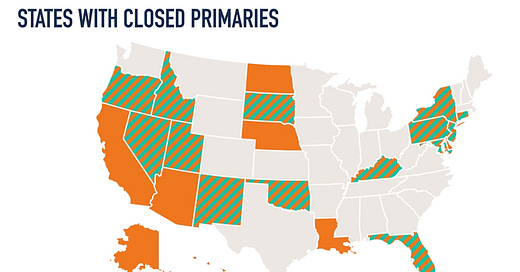Closing the Ohio Primaries for Dummies
With a Legislative Analysis for Law Makers - Include the "Independent Ballot" to avoid legal challenges and possible future repeal.
By Jon Morrow
Imagine showing up to vote in Ohio’s primary election and being told: “Sorry, unless you belong to a political party, you can’t vote for anyone.” That’s how our system works now (yes, Ohio has issue only ballots - but no candidates are on the issues only ballots). If you're one of the millions of Ohioans who aren't registered as a Republican or Democrat, your primary options are limited to a short “issues-only” ballot — with no say in who gets nominated for Governor, Congress, or President. It also prevents participation in many local partisan races.
In many cases that seems like it’s not fair. And it doesn’t make for better candidates, either.
That’s why Ohio should adopt a Three-Party Primary System — one that treats voters fairly, respects political parties, and improves competition. Here’s how it would work — and why it’s the smartest way forward.
This is a comprehensive analysis of the proposed Three-Party System. Just click the button above ^^^^^.
🍦 Three Choices, Not Just Two
Right now, Ohio’s primaries are like a grocery store with only two checkout lanes — Republican and Democrat. If you’re not in one of those lines, you’re just browsing.
The new Three-Party System would add a third lane — an Independent ballot — for the growing number of voters who don’t belong to either party.
🟥 Red Ballot – For Republicans
🟦 Blue Ballot – For Democrats
⚪ White Ballot – For Independents
You pick the lane that matches your affiliation. No pressure. No tricks. If you’re independent, you still get to vote in the primary — it’s just that the parties may elect to not include independents votes in the parties’ nominating contests. This gives everyone a voice while keeping the parties' processes honest and allows the parties to associate with who they want and voters to associate with who they want.
🧭 Why Close the Primaries?
Under the current system, voters can “party-hop” on Election Day. You could vote in one party’s primary this year and another’s next time — no commitment required. That opens the door to “party raiding” — when people jump into the other party’s primary just to mess with the results.
That’s like being a Browns fan, buying a Bengals jersey for one day, and voting on who should be their quarterback. It's not right.
Parties deserve to pick their nominees based on the input of the people the party believes actually supports them. The Three-Party System protects this by letting only registered party members vote in that party’s primary — and giving independents their own lane instead of pressuring them to choose sides. A political party can impose a waiting period to further dissuade party hopping.
⏳ A Waiting Period? Here’s Why.
What if someone switches parties just before a primary, not because their views changed, but to sway the outcome? For example, maybe they hop parties just to vote for the candidate that is easier for their true party to beat. That’s a problem.
This plan lets each party set a waiting period (up to 4 years) for new members before their votes count toward picking nominees. That doesn’t stop anyone from switching parties — it just means you’ve got to stick around for a bit before your vote counts in making big decisions. - your vote will still be tallied but won’t count towards deciding who the nominee will be.
Think of it like joining a club. You don’t get to run the place the first week you show up. You normally have a waiting period before you can run for club officer.
Additionally, let’s say that you belong to the Ohio Republican or Democrat Party or other minor party - pulling an independent ballot does not affect your partisan affiliation.
🧠 Better Information = Better Choices
Under this new system, candidates can also list up to 10 caucuses or groups they’re affiliated with — like “Pro-Life,” “2nd Amendment,” “Environmental,” or “Labor.” That way, when you see “Jane Doe (R)(RTL)(VET)(TAX),” you know more about her priorities right on the ballot and can therefore make better decisions..
No more guessing where candidates stand on the most popular issues. It’s like seeing a nutrition label before buying your food.
🗣️ Voter Voices Matter
Finally, this proposal lets state and county parties ask their voters real questions every two years during big elections — up to 20 questions statewide and 10 locally. These questions would be things like:
Should Ohio eliminate the state income tax?
Should our party support school choice?
The answers wouldn’t change laws, but they’d show party leaders what real voters think. Instead of guessing what “the base” believes, the base would literally vote on it and give their leaders guidance.
That’s how you make political parties listen again.
⚖️ Why This Works
The courts have ruled over and over: parties get to choose who helps them pick their candidates — and voters have a right to freely associate with whatever party they choose. The Three-Party System respects both.
It protects parties from sabotage.
It gives voters clear choices.
It invites independents to participate — just not as party crashers.
More importantly, it leads to better competition. Parties can no longer rely on sneaky strategy. They’ll have to earn loyalty by offering strong ideas and strong candidates.
And when parties compete fairly, we all win.
Final Thought:
Ohio’s current system is outdated. It was designed for a time when voters were loyal to just two parties. But today, most Ohioans don’t belong to either. It’s time to build a system that fits the 21st century.
The Three-Party Primary System is fair, balanced, and smart. It gives voters more voice, gives parties more integrity, and gives candidates more incentive to be their best.
Let’s fix the primary. Let’s make Ohio elections better for everyone.





